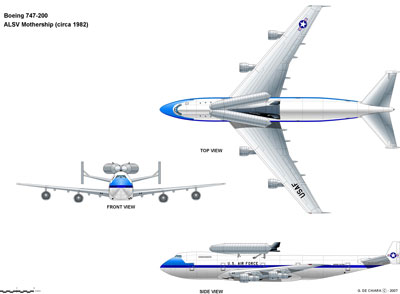Fire in the sky: the Air Launched Sortie Vehicle of the early 1980s (part 2)by Dwayne Day
|
| “Based on a first cut analysis it appears to be a feasible system,” GD’s Ketchum wrote. |
The 747 that Hart had discussed for the carrier aircraft was no ordinary jumbo jet—it would have been an absolute hot rod, equipped with hydrogen-burning afterburners. The standard thrust for each JT9D engine would have been 55,233 newtons (12,417 pounds-force). With afterburner, that jumped to 230,111 newtons (51,731 pounds-force) of thrust. The pilots would take the carrier with the spaceplane on its back to 10,700 meters (35,000 feet). At this point they would begin pumping fuel into the spaceplane’s drop tank. Once it was topped off, the pilots would light the afterburners and climb to 12,200 meters (40,000 feet). They’d pull up on the nose slightly, and twenty seconds later they would begin a pitch over as the spaceplane separated off the back of the carrier.
Ketchum’s study assumed that the spacecraft would use two Atlas E tanks, each ten feet in diameter and approximately sixty feet long. His team modeled the lifting ascent trajectory to carry 7,700 kilograms (17,000 pounds) to a 185-kilometer (100-nautical-mile) circular orbit. What they determined was that the baseline system was deficient by 200 meters per second (650 feet per second) in velocity needed to achieve orbit. Despite this, there were a number of performance parameters that could be varied to make up this difference and give the spaceplane enough power to reach orbit. These included engine performance, propellant weight, and the weight of the vehicle without fuel. “Based on a first cut analysis it appears to be a feasible system,” Ketchum wrote.
Although the details of General Dynamics Convair’s assessment remain sketchy, pages that were attached to Ketchum’s memo indicate that GD also looked at a more radical solution to improve performance: a fluorine rocket.
Most people know of fluoride in relation to toothpaste, dentists, and strong teeth. It was one of the things that General Jack D. Ripper was convinced was part of a communist plot in Dr. Strangelove, and even today there are many people in Great Britain who are convinced that it’s dangerous. Lots of people believe lots of silly things, but here they deserve to be cut a little bit of slack, because fluorine, the element that fluoride is based upon, is a nasty material. In pure form it is a clear, pale yellowish-brown gas that is highly reactive and poisonous. The stuff will kill you. It also makes for a kickass rocket fuel.
Rocket designers have known since early in the days of liquid fuel rockets that fluorine and liquid oxygen—a combination known as FLOX—theoretically offered very high performance, better than just about anything else possible. But the mixture was both highly reactive and cryogenic, and therefore extremely hard to handle. Spill other rocket fuels, such as kerosene or liquid hydrogen, and although they posed dangerous explosive hazards, they could be handled and the danger would dissipate. Fluorine, on the other hand, will spontaneously ignite if it comes into contact with hydrocarbons, such as grease.
| In pure form fluorine is a clear, pale yellowish-brown gas that is highly reactive and poisonous. The stuff will kill you. It also makes for a kickass rocket fuel. |
General Dynamics engineers knew of fluorine’s bad reputation, but nevertheless felt that it had gotten a bit of a bad rap. In a two-page memo by an unknown author, they noted that “safe handling of large quantities of fluorine has been demonstrated by Rocketdyne, Aerojet, Pratt and Whitney, Convair, LMSC, and others.” They even noted that “Convair performed a study for AFRPL of a hydrogen-fluorine orbit-to-orbit stage to be operated with the shuttle” from Vandenberg Air Force Base.
Hydrogen-fluorine offered the greatest performance, with a specific impulse—a measurement of the change of momentum per amount of propellant used—of 495 seconds, compared to a mere 470 seconds for the recognized rocket propellant champions of liquid oxygen and liquid hydrogen. What this meant was that hydrogen-fluorine could produce more power out of less propellant mass, resulting in overall better performance. It was particularly attractive for single-stage-to-orbit spacecraft, or the kind of spaceplane that could fly off the back of a 747 (the GD engineers apparently did not consider the 747 to be a “stage”). It could eliminate drop tanks. One such version was illustrated in a page attached to the memo.
The big problem was that fluorine reacts with water, and water is, well, just about everywhere the Air Force operates. Building a fluorine rocket system and keeping it sealed and dry for one use was possible, but building one that would be available for reuse was too risky. Maintaining and reflying it would risk exposing it to water or other contaminants and this would increase the danger of explosion. There was also one other problem: the exhaust consisted of hydrogen fluoride, a truly horrible toxic gas that they did not want to dump into the atmosphere.
Nevertheless, the performance offered by this nasty propellant was just too great, and engineers love new challenges. Whoever wrote the memo about fluorine recommended that the company continue efforts to develop methods and systems for maintaining dry, clean, reusable liquid fluorine systems, evaluate the effect of adding all that hydrogen fluoride to the atmosphere, and study engine design and operation philosophy.
Although General Dynamics engineers concluded that the Air Force Space Sortie System was feasible, it is not known if the company performed any detailed studies of the concept. Another company, Boeing, did.
(The GD memo can be downloaded here.)
